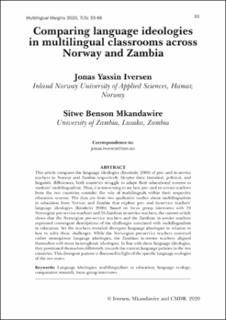Comparing language ideologies in multilingual classrooms across Norway and Zambia
Peer reviewed, Journal article
Published version

Permanent lenke
https://hdl.handle.net/11250/2787792Utgivelsesdato
2021Metadata
Vis full innførselSamlinger
Originalversjon
Multilingual Margins. 2020, 7 (3), 33-48Sammendrag
This article compares the language ideologies (Kroskrity 2000) of pre- and in-service teachers in Norway and Zambia respectively. Despite their historical, political, and linguistic differences, both countries struggle to adapt their educational systems to students’ multilingualism. Thus, it is interesting to see how pre- and in-service teachers from the two countries consider the role of multilinguals within their respective education systems. The data are from two qualitative studies about multilingualism in education from Norway and Zambia that explore pre- and in-service teachers’ language ideologies (Kroskrity 2000). Based on focus group interviews with 24 Norwegian pre-service teachers and 36 Zambian in-service teachers, the current article shows that the Norwegian pre-service teachers and the Zambian in-service teachers expressed convergent descriptions of the challenges associated with multilingualism in education. Yet the teachers revealed divergent language ideologies in relation to how to solve these challenges. While the Norwegian pre-service teachers conveyed rather monoglossic language ideologies, the Zambian in-service teachers aligned themselves with more heteroglossic ideologies. In line with these language ideologies, they positioned themselves differently towards the current language policies in the two countries. This divergent pattern is discussed in light of the specific language ecologies of the two states.
Beskrivelse
© Iversen, Mkandawire and CMDR. 2021. All work in this journal is licensed as Creative Commons Attribution No Derivatives 4.0: CC-BY-4.0
